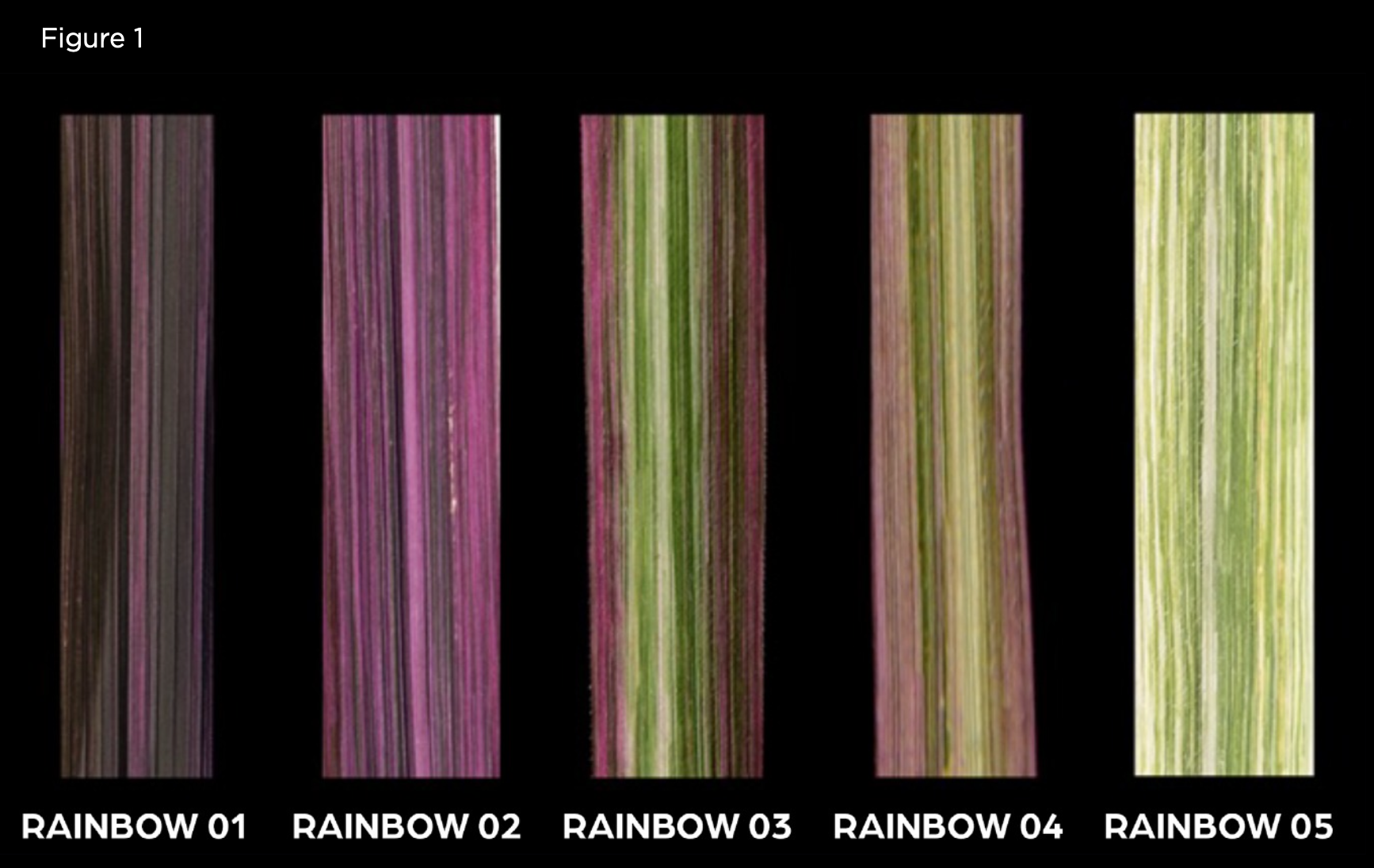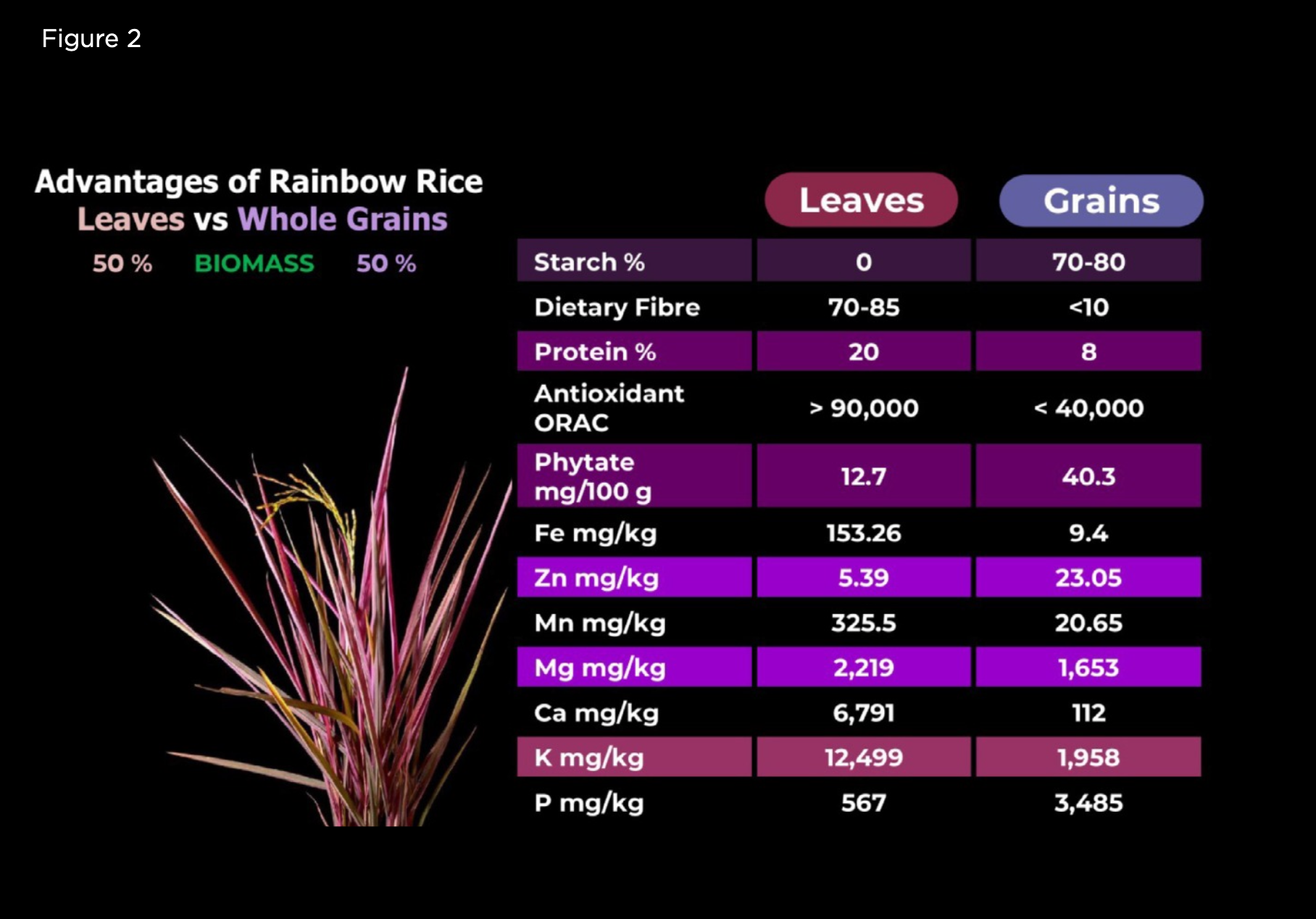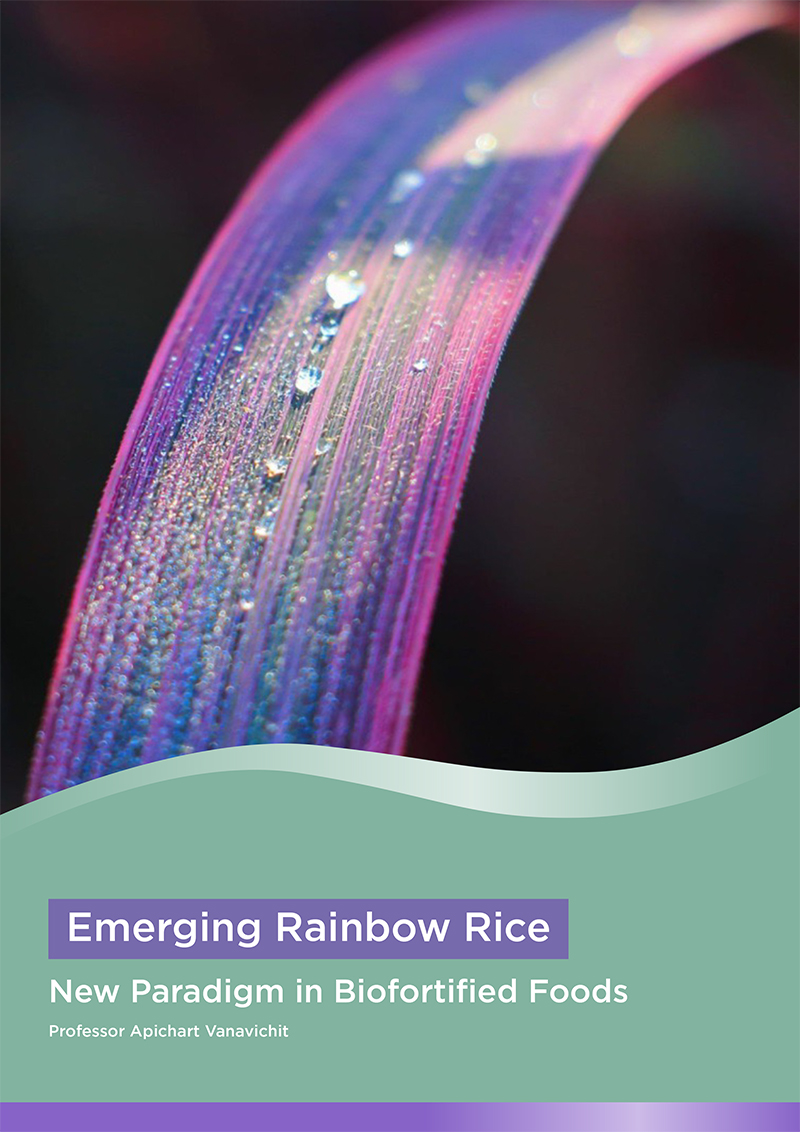Rainbow Rice originated from comprehensive cross-breeding between a rare white-stripe leaf mutant and a dark purple leaf rice for a decorative purpose; however it has become a new model for biofortified foods and agrotourism
Secure better foods for a self-sufficient future
In 2050, the world must produce at least 40% more crop calories to feed 9.8 billion people. With limited suitable agricultural land, water resources and the imminent threat of global warming, increasing rice production will eventually lag behind the population explosion.
Nonetheless, the growing triple burden of malnutrition (TBM), the coexistence of undernutrition, obesity, and micronutrient deficiency, reflects the world’s unequal food distribution, unhealthy food choices and lifestyles. Under such circumstances, will nutrient foods be secure? For the first time, we designed a rice leaf to orchestrate unusual chlorophyll, anthocyanin, and carotenoid patterns for eye-catchy rice plants loaded with antioxidants, protein, and micronutrients.

The origin of Rainbow Rice
Rainbow Rice originated from comprehensive cross-breeding between a rare white-stripe leaf mutant and a dark purple leaf rice for a decorative purpose. From a long-term visual selection, we came up with five unusual, distinctive lines expressing vivid cherry-red, cherry- pink-purple-green, and white-green stripes.
The combinations of colourful pigments, flavonoids, chlorophyll, and carotenoids, define unique patterns of cherry-red, pink, purple, green, and white stripes analogous to a rainbow-like ribbon. Rainbow Rice has become a new model for biofortified foods and agrotourism (Figure 1).
The game changer: Consuming rice leaves
The increasing prevalence of obesity and diabetes forces us to rethink which sources of nutrients are missing in high-caloric foods. Starchy foods induce more insulin to control metabolic glucose. But when insulin does not function properly, we develop insulin resistance, metabolic syndrome and NCDs. We must consume less rapidly digestible starch to slow down metabolic syndrome but increase dietary fibre, protein, and antidiabetic elements.
Here, we show you rice leaves can provide such missing nutrients. As the whole plant biomass comprises about half and half leaf-straw and grain yield, we can compensate starchy grains with essential nutrients from leaves. Farmers will gain significantly more income from selling high-quality leaves instead of burnout and causing air pollution. But so far, we have never used rice biomass as human food. We set research goals to enrich leaf nutrition, minimise food allergens and mitigate triple-burden malnutrition. For the first time, we have undertaken this challenge to demonstrate the advantage of Rainbow Rice leaves as human foods.
Biohacking with Rainbow Rice
Our results showed that the Rainbow Rice leaf comprises 50-66% insoluble and 1-5% soluble dietary fibre, antioxidants, 14-20% protein content, enriched minerals and micronutrients and minimum antinutritive factors. Therefore, these leaves have a high potential to address food and nutrition security.
Not only rich in dietary fibre, Rainbow Rice leaves are essential sources of minerals and micronutrients. Their young-vegetative leaves contain 3-4% nitrogen (N), 1.1-1.6% potassium (K), and 0.2-1% calcium (Ca), but a minute amount of phosphorous (P). In particular, Rainbow Rice leaf is enriched with iron (2.9-16.9 mg/100 g Fe), manganese (8-18.9 mg/100 g Mn), and magnesium (1.2-2.5 mg/100 g Mg). Leaves concentrate more on minerals and micronutrients than whole grains, except for lower P and Zn (Figure 2). Because of a low antinutritive factor, Phytic acid, known to bind Fe and P in plants, leaf Fe is freely available for absorption during digestion.
The unique colour feature of Rainbow Rice leaves determines the antioxidant activities of the leaf extracts, which contain anthocyanin, carotenoids, xanthophyll and chlorophyll. These phytochemicals play essential roles in anti- inflammation incurred by obesity (OB), cancer, diabetes (D2B), and cardiovascular diseases (CVD). Among the Rainbow Rice varieties, the two cherry-red leaf lines contained ten times more anthocyanidins and phenolic compounds than any other leaf colour.

Grains of hope
Different varieties of Rainbow Rice produce different types of mature whole grain, purple sticky rice (RB02 and RB04), purple non-sticky rice (RB01 and RB05), and brown non-sticky rice (RB03). Whole grains contain 76-85% starch, unlike the very little starch in their colourful leaves. In contrast, whole grains have only 3-5% of total dietary fibre compared to 56-67% in their leaves.
The minerals and micronutrient contents were much lower in N, K, Ca, Fe, Mn, and Mg in whole grains than in their leaves, except P and Zn. In contrast, we found higher P, Zn, and phytic acid content in whole grains than in leaves. Protein contents of the whole grains ranged from 9-14%, compared to 14-20% in their leaves. Furthermore, RB02 and RB04 contain exceptionally high proteins at 13.26% and 14%, respectively. These leaves and grains are by far the hope for developing plant-based protein and therapeutic protein hydrolysate in the crop that provides 50% of calories needed for half of the world.
Prebiotic and Antidiabetic Potentials
Gut microbiota is crucial to human and animal wellbeing, both vegans and carnivores. The diversity of gut microbiota affects immune sensitivity, Irritable Bowel Syndrome (IBS), Inflammatory Bowel Disease (IBD), Obesity (OB), Type-2-Diabetes (T2D) and cardio-vascular diseases (CVD). FAO and WHO (2002) defined Prebiotics as indigestible and non-absorbable nutrients leftover from the human digestive system to gut microbiota.
Prebiotics comprise oligosaccharides such as fructo-oligosaccharide (FOS), galacto- oligosaccharide (GOS), malto-oligosaccharide (MOS), xylo-oligosaccharide (XOS), resistant starch, raffinose, and inulin. The microbial residents affected the host’s wellbeing by providing various functional molecules to multiple organs. Rainbow Rice leaf comprises 60-70% dietary fibre, mainly insoluble dietary fibre (IDF), which defines Prebiotics.
The essential functions of Prebiotics are protecting Probiotics and diversifying resident microbiota. Here, we tested Rainbow-Rice-derived Prebiotics on two Probiotic strains, L.rhamnosus and L.rueteri, from in vitro digestion using gut-like enzymes. Subsequently, we showed that the Probiotics could produce short-chain fatty acids (SCF) in vitro.
Then, we introduced Rainbow Rice Leaf Powder (RBLP) to a local homemade baker to improve bakery products’ nutritional value. White bread is typically considered a high glycemic index food, a root cause of obesity and type-2- diabetes. The local homemade baker successfully mixed the ingredient into bread dough to lower its glycemic index (Figure 3). The preliminary results were very satisfying. Adding up to 10% of the leaf supplement did not affect bread texture, loaf volume, and after-taste. Instead, consumers scented green tea with a characteristic green colour bread.
The bread had lowered its in vitro glycemic index from 95 to 86 when adding only 1.5% RBLP leaf. We will further evaluate the effects on antidiabetic responses and fullness factors for bread and other bakery products. By adding more dietary fibre, we consume less wheat starch and more dietary fibre, reducing the risk of NCDs. In the long term, the increasing demand for RBLP will stimulate more expansion and increase the value of Rainbow Rice leaves. Figure 3:
Improved vision loss
Vision loss is more common among ageing populations and the smartphone generation. The critical cause is the damaged macular tissue caused by oxidative stresses, called Macular Degeneracy (MD). The macular fovea locates a vital receptor of images via retinal pigments. Potent antioxidants and phytochemicals, including Beta-carotene, Lutein, Zeaxanthin, Xanthophylls, and Anthocyanins, are slowing down MD. Rainbow Rice leaves contain Carotenoids, Xanthophylls, two common Anthocyanins, Cyanidin-3-glucoside, peonidin-3-glucoside, and a unique Cyanidin-3-Rutinoside.
First, we isolated phytochemical fractions showing the Human Retinol Pigment Epithelial cell line (RPE) protection from oxidative stresses. The in vitro studies and MD-induced animal model lines will pave the way to develop innovative therapeutic products from Rainbow Rice leaves to prevent age-related MD.
Stop open-field burning
Open-field burning has created widespread air pollution from rice farmings in Asia. Rice farmers in the tropics believe in stubble burning to control local pests and facilitate subsequent soil preparation. The “Burning Season” creates smoke and suffocates the city and surrounding rural regions. A tiny particle, PM2.5, can damage your lung, leaving residents susceptible to lung diseases while creating greenhouse gases that worsen the impacts of climate change.
Using whole rice biomass instead of burning the waste can help combat climate change. The leftover biomass after harvest is beneficial as hays, biofuel, soil improvement, futon and mulching. Burning rice straws in open fields and traditional cultivation methods such as flooding paddy fields contribute approximately 10% of global man-made methane, a potent greenhouse gas.
Create unseen Agrotourism
Rainbow Rice creates a scenic landscape when grown in the winter season in Thailand. We have now established Rainbow Rice Valleys on focal farm areas to create new unseen tourist destinations around Thailand. We have developed a deep value chain to channel Rainbow Rice leaves and grains to novel functional food industries.
Paradigm change
Direct consumption of fibre-rich rice leaves is a challenge for human foods. As functional ingredients, we first developed a freeze-dried powder from young leaves to preserve antioxidants and heat-sensitive nutrients. Here, we describe the potential applications of functional elements and isolated phytochemicals from whole leaves and grains of Rainbow Rice as a Prebiotic, antidiabetic, antioxidant and dietary fibre supplement.
Discovering new functional properties of isolated leaf proteins will widely open for high-quality plant-based protein products from highly abundant rice leaves.
Acknowledgement
These projects have been supported by the Rockefeller Foundation from 2020-2022 and the National Research Council Thailand (NRCT) since 2023.


